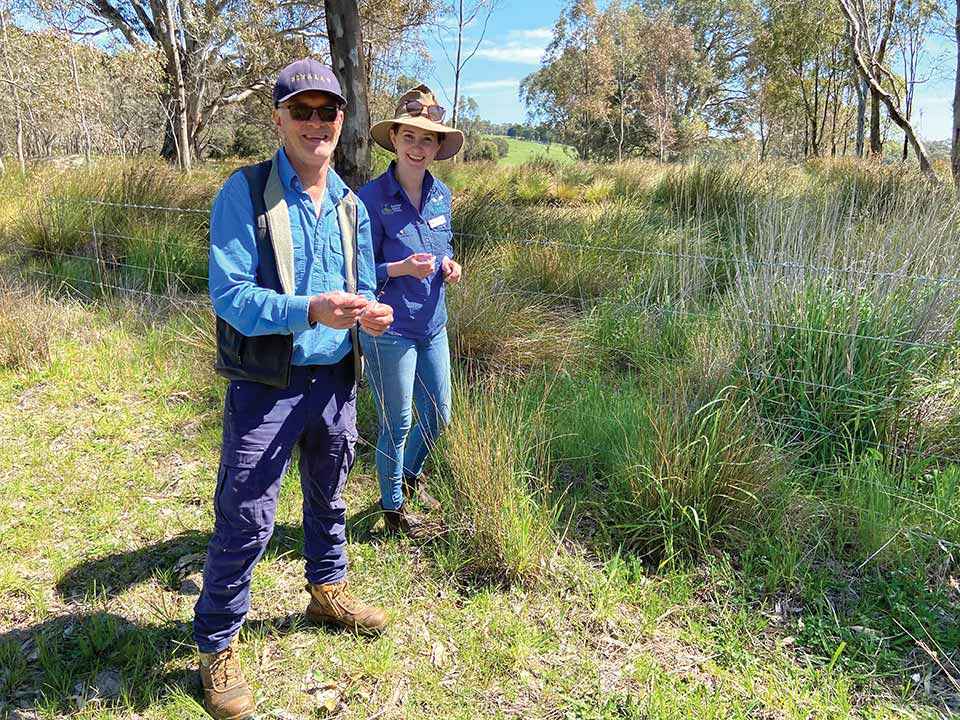Victorian Landcare Magazine - , Issue 89

Since 1984 the Warrenbayne Boho Land Protection Group (WBLPG) has been active in protecting and managing critical natural assets such as soils, water and vegetation. Over many years the group has sought expert facilitation from many different organisations, providing landholders with the knowledge and skills needed to tackle serious environmental issues.
This collaborative approach now guides the group back to one of the most valuable tools landholders can use – Whole Farm Planning.
WBLPG members first undertook Whole Farm Planning in the early 1990s. The process provided a format for getting neighbours together so that on-ground works could be cooperatively and strategically planned. It worked.
Forty years later WBLPG has a new and diverse generation of landholders who are interested in assessing their properties and understanding land management issues. The process enables them to address these issues and see how their actions affect the surrounding area. It gives landholders a plan for the future and is often the prompt for them to begin their own on-ground works.
Realising that our old standby, Whole Farm Planning, was the most effective method of engaging new landholders was a back-to-the-future moment for the group.
With funding from the 2023 Victorian Landcare Grants, we designed four Whole Farm Planning workshops covering soils, sustainable farming, natural capital accounting, protecting waterways, remnant vegetation and biosecurity issues. Landholders were provided with large maps of their properties in order to identify natural and built assets, and plan future works. Most importantly, they were provided with key knowledge about the land they had custodianship of through a series of targeted sessions with experts.
Our experts included Angelina Siegrist and Amber Croft from the Australian National University Sustainable Farms team, and Dr Jim Radford, head of La Trobe University’s Research Centre for Future Landscapes.
Realising that our old standby, Whole Farm Planning, was the most effective method of engaging new landholders was a back-to-the-future moment for the group.
Sustainability was a major focus of the workshops. All our participants were questioning how to be sustainable while still having a thriving farm business. According to Dr Jim Radford, it is about putting the environmental value of Australian farms squarely on the ledger.
“Fifty-eight per cent of the Australian continent is used for agriculture, but that conventional measuring and accounting fails to log the natural assets of properties, on both the plus and minus sides of the ledger,” Jim said.
This resonated with the group who, although managing a range of large-and small-scale properties, could relate to the idea of valuing natural assets. How could we farm without these?
La Trobe University’s research themes include building resilient rural communities – including the environment – and driving more sustainable food production.
Jim gave an example of how these themes are being taken up around the world; for example from 2023 all garments sold in the European Union will need to have their sustainability footprint labelled.
“It’s not just carbon footprint, it’s their biodiversity impact and a range of other metrics,” Jim said.
We saw the need to follow on from the targeted workshops with a field day to show our new landholders what a sustainable farm environment looks like. Rotherlea was an obvious choice as it was one of the first properties in the group project area to embark on Landcare works.
In October 2024 more than 20 participants gathered at Rotherlea for a field day to hear Angelina Siegrist and Amber Croft sharing their Sustainable Farms research. We learnt about Natural Asset Farming – protecting and enhancing natural assets to create productive and biodiverse farms.
Old paddock trees that had protected for many years were still providing crucial habitat for wildlife and functioning as stepping stones for connectivity.
Participants looked at revegetation sites and discussed important factors such as location, understorey, establishment of vegetation around farm dams, and how connecting plantings to other plantings provides better outcomes than isolated revegetation. Old paddock trees that had been protected for many years were still providing crucial habitat for wildlife and functioning as stepping stones for connectivity.
Eleanor Sadler, a young farmer who attended the field day said, “seeing this has helped me understand the importance of fencing and revegetating our farm dams. Water quality is improved for stock, biodiversity is enhanced and methane emissions are reduced.”
The field day provided a new generation of land managers with lessons learnt over many decades. It was inspiring to see what can be achieved.
WBLPG gratefully acknowledges the support and assistance it receives from Gecko CLaN Landcare Network for facilitating projects and helping with submission writing.
Meredith Paez is secretary of WBLPG. For more information wblpgsecretary@gmail.com